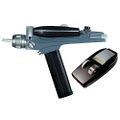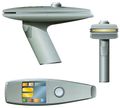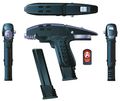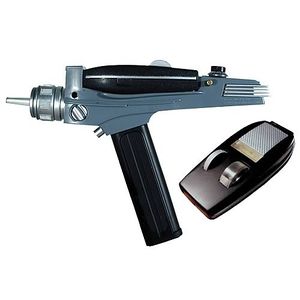
The Federation phasers fire nadion particle beams. While other phasers use various kinds of phased plasma particle beams, this type of particle beam is considered to be the most refined and efficient. A wide variety of energy settings along with beam width and geometry make the phaser a highly versatile weapon.
Types

Phasers come in two distinct classes of weapon. Much like conventional projectile weapons, they scale up from the hand held versions (as seen in the images below) to models for vehicle, space vessel, or even space station and planetary defenses. The compressed nadion beam works effectively well for vessels as well as star bases, and orbital satellites. Progressing from single emitters extended from the hull used in the crude phase-cannons employed by 22nd century vessels to banks (with two or more emitters each) used in 23rd century designs. Modern 24th century vessels use full arrays of emitters which all provide nadion energy into the array which is then directed out as a single beam from the array at a controlled point. This is obvious when initialized before firing where energy can be seen moving along the array from each end point to meet where the beam is generated at on the array.
Settings
Phasers can be set to stun a person by shocking the nervous system with nadion radiation but transferring minimal heat into tissues. This shocking effect can cause drowsiness at low power but at higher power causes unconsciousness. There is a tradeoff, the higher the power the more heat and nuclear dispersion force is transferred to the tissues. Cells impacted with too much nadion radiation over time, will become damaged. Stun beams can also be cumulative making repetitive stuns damaging to tissues even at low settings after repeated exposure in a short time frame.
Stun Resistance
It is possible to stun resistant creatures but the phaser must be configured specifically force such an assault to assure minimal tissue damage.
High Power
At high settings the nuclear dispersion force caused by the beam is enough to cause a chain reaction and vaporize a target of significant size, though the exact size and shape of the object or section of a large object to be vaporized depends greatly on the object itself and the beam settings.
Phasers at Tools
Phasers can be used to heat rocks or other dense objects to provide heat in extremely cold environments or other survival situations. They can also be used to melt rock or metal using similar methods. Some rocks or materials instead of melting have a chance of exploding unless the beam is specifically calibrated to melt the material.
Large Phaser Installations
Ships, buildings, and stations can all use phaser weapons as a primary defensive and offensive technology as well by using larger emitters and higher power than handheld devices. These are just as versatile on a large scale capable of being used as utilities to cut through asteroids or through the crust of a planet to facility transporting of trapped victims or scientific study.
22nd and 23rd Century
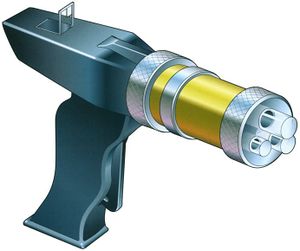
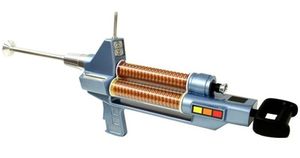
These original phasers replaced the Phase Pistols used previously. They were bulky and had crude control of the beam intensity and geometry. Because of the kind of beam they created many people in the early days of the technology mistakenly called them lasers, turbo lasers, or some other such comparison to laser technology. Control of the beam was accomplished by rotating and moving the outer rings along the barrel of the weapon.
Introduced at this time as-well was the phaser rifle. The rifle had greater firing power, accuracy, and range. However, it still had the same kinds of crude controls.
23rd Century
In the mid 23rd century phasers were radically updated. They became smaller and more reliable with greater control of both beam geometry and energy output. These more reliable units had more power and could be controlled using dials or buttons to adjust settings making them far more accurate for a given task.
-
Types 1 and 2 Rev 1
-
Type 1 Rev 2
-
Type 1 Rev 3
-
Assault Type
The phaser rifle was also used far less during this time because the pistol design became more powerful and made it an easier weapon to use. The rifle design from the early 23rd century was retained throughout this time period.
Development also heavily went into the development of a very small handheld phaser weapon (termed a Type-1 phaser) for Starfleet personnel to carry on their person without it being obvious they had a side arm. Generally speaking it has half to two-thirds of the power output of the pistol (termed a Type-2 Phaser). In some models of Type-2 phasers the Type-1 is actually part of the design making the Type-2 weapon an extension of the Type-1.
Though toward the end of the 23rd century this kind of design was being moved away from, though some later models still retained the Type-1 in Type-2 design, rarely were they seen separated because in those designs the Type-2 is useless without the Type-1.
24th Century

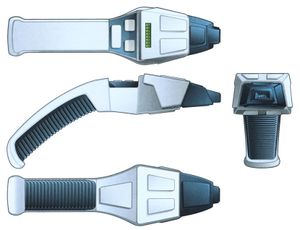
By the end of the 23rd century phaser technology had continued to increase considerably in both accuracy and control. The design shifted away from previous gun based designs and used a more ergonomic straight design.
The production of a Type-1 and Type-2 phaser also continued, though the Type-1 was no longer included in the design of the Type-2 and they became entirely separate devices. While both types remained fairly standard with only minor changes the phaser rifle was completely redesigned toward the latter half of the 24th century.
Rifle Update
The rifle design was also updated during this time along the same lines. More power, better controls, higher accuracy.
-
Early to Mid 24th Century
-
Mid to Late 24th Century
-
Late 24th Century (Current)
